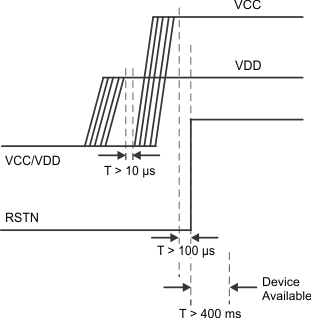SLASE51A November 2014 – November 2014 TVB1440
PRODUCTION DATA.
- 1 Features
- 2 Applications
- 3 Description
- 4 Simplified Schematics
- 5 Revision History
- 6 Pin Configuration and Functions
- 7 Specifications
- 8 Detailed Description
- 9 Application and Implementation
- 10Power Supply Recommendations
- 11Layout
- 12Device and Documentation Support
- 13Mechanical, Packaging, and Orderable Information
Package Options
Mechanical Data (Package|Pins)
- RGZ|48
Thermal pad, mechanical data (Package|Pins)
- RGZ|48
Orderable Information
10 Power Supply Recommendations
The following power-up and power-down sequences describe how the RSTN signal is applied to the TVB1440.
10.1 Power-Up Sequence
- Apply VDD then VCC (recommended both less than 10-ms ramp time). VDD must be asserted first and stable for greater than 10 μs before VCC is applied.
- RSTN must remain asserted until VCC/VDD voltage has reached minimum recommended operation for more than 100 μs.
- De-assert RSTN (Note: This RSTN is a 1.1V interface and is internally connected to VDD through a 150-kΩ resistor).
- Device will be available for operation approximately 400 ms after a valid reset.
 Figure 15. Power-up Sequence
Figure 15. Power-up Sequence
10.2 Power-Down Sequence
There is no power-down sequence required.